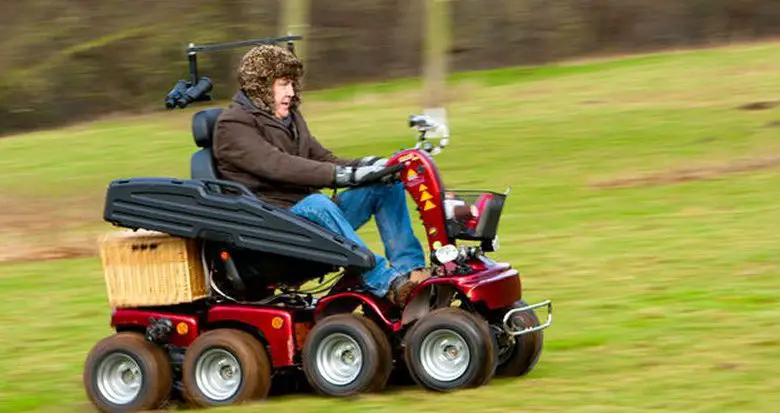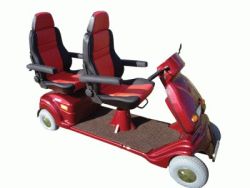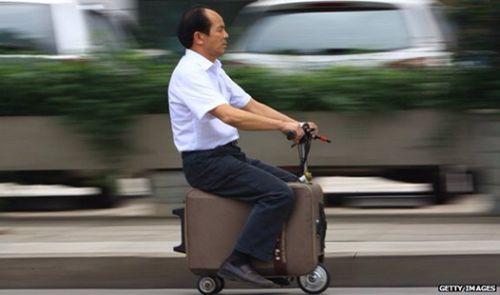
The great mobility scooter debate
This is an updated post from our archives, exploring the ongoing debate around mobility scooters. Are they a vital tool for independence or an inconvenience on pavements and public spaces? We address common misconceptions, legal considerations, and how mobility scooters contribute to accessibility for disabled people.
Well mobility scooter users are a bit like that, have you noticed? All different types of people use them, in all sorts of ways – do the phrases boy racer, road hog or down right oblivious mean anything to you?…
Technology is a wonderful thing, and having used a powered wheelchair for some twenty five years, I’m a big fan of mobility aids. The ability to stay active in our families, our communities, and at work, is seriously enhanced by powered wheelchairs and scooters. Some of my best friends use mobility scooters. But there’s no easy way to say this: some motorised scooter users are a pain in the backside! There, I’ve committed the cardinal sin of criticising other disabled people.
Whilst the majority of scooter users are considerate, careful, and take account of other people, some should be required to re-train or stay at home. In my mind I’ve taken to categorising and, yes, labelling scooter users, again probably unfairly for some, but bear with me…
The most obvious is the male-menopause-chrome-and-wing-mirrors rider: he (although there are some women) sees the motorised scooter as a way to regain his lost rebel years. He has polished accessories, go faster stripes and a souped up motor. If he’s really keen he’ll ride on the road – technically, in the gutter, but hey – or terrorise the pavement. And oh yes, his scooter is BIG and his attitude to walking pedestrians is suitably dismissive.
And then there’s the zombie rider: sometimes these go in pairs, rarely looking where they are going, blithely and unconsciously cutting a swathe through the pedestrians, who stroll along at their peril. The zombie rider was probably an inconsiderate pedestrian before they became a scooter user, who bumped into people all the time. But back then the odd bump didn’t really matter, or at least it didn’t really hurt anyone – that’s not the case now! Beware the zombie rider…
We’ve probably all seen the shopaholic rider, usually a kind of mobile version of the ‘bag lady,’ with carrier bags and shopping bags hanging from every available part. They’re often seen trying to get through a space that is just too small, scraping past you and knocking to the floor anything that is untethered. They remain blissfully unaware that some spaces in shops and stores are too small for their machines, and motor on regardless in their retail quest.
 Closely related to the shopaholic is the demolition man rider, who has absolutely no spatial awareness, sense of responsibility or sense of personal space. This rider will back into you – accompanied by a loud beep, beep, beep – and run over your toes with alacrity. And if you get hurt? Well for some reason you find yourself apologising to them as you rub your foot!
Closely related to the shopaholic is the demolition man rider, who has absolutely no spatial awareness, sense of responsibility or sense of personal space. This rider will back into you – accompanied by a loud beep, beep, beep – and run over your toes with alacrity. And if you get hurt? Well for some reason you find yourself apologising to them as you rub your foot!
The undecided rider is maybe to be sympathised with – leave the scooter outside or take it in? Go on the road or on the pavement? Leave the soft top up when you go in the supermarket or take it down? It’s as if they can’t decide whether they’re a pedestrian or not, and if they’re a pedestrian whether to run or walk.
 But a favourite of mine is the double scooter – the ‘buy one, get one free’ that I’ve only seen used in Tenerife. This scooter has a longer wheelbase and two seats, one in front of the other. It’s always been used by a man and a woman, and the man always drives, often wearing some kind of flat cap. It looks a bit like an old fashioned Sunday outing. I fondly imagine they have a picnic hamper and flask stashed away for when they find a nice spot to stop and look at the view.
But a favourite of mine is the double scooter – the ‘buy one, get one free’ that I’ve only seen used in Tenerife. This scooter has a longer wheelbase and two seats, one in front of the other. It’s always been used by a man and a woman, and the man always drives, often wearing some kind of flat cap. It looks a bit like an old fashioned Sunday outing. I fondly imagine they have a picnic hamper and flask stashed away for when they find a nice spot to stop and look at the view.
These are the major characters and here, last but not least, is the scuba diving scooter rider – oh, no, not a good idea!
By Lorraine Gradwell
Mobility Scooters: Independence vs. Public Perception
Mobility scooters have transformed the lives of many disabled people, offering independence and freedom of movement. However, public perception often fluctuates between admiration and criticism. Some view them as essential assistive technology, while others argue they contribute to pedestrian congestion. But how much of this debate is based on fact?
Legal Rights and Responsibilities
Mobility scooters are legally classified into two categories:
- Class 2 Scooters – Limited to pavements (max speed 4mph) and cannot be used on roads.
- Class 3 Scooters – Road-legal models (max speed 8mph) that must be registered with the DVLA.
Knowing these classifications helps address concerns about misuse.
Common Misconceptions
Many myths surround mobility scooter users, such as:
- They are “dangerous” – In reality, most accidents occur due to inadequate infrastructure, not the scooters themselves.
- They are only for elderly people – Many younger disabled individuals rely on them for independence.
- Users do not require training – While no formal test is needed, responsible driving and awareness are crucial.
Solutions for a More Accessible Future
To reduce conflicts, urban planning must accommodate diverse mobility needs. Wider pavements, designated scooter lanes, and public education campaigns can help. Additionally, choosing a model that fits individual needs is crucial. For those looking for reliable mobility scooters, check out this selection of mobility scooters designed for comfort and accessibility.
Mobility Scooter Safety: Addressing Rising Fatalities
While mobility scooters enhance independence, safety concerns have grown in recent years. According to recent reports, there has been a rise in mobility scooter-related fatalities, leading to new discussions around better safety measures.
Key Safety Concerns
- Visibility Issues: Many accidents occur due to scooters not being easily seen by other road users, especially in low-light conditions.
- Lack of Training: Unlike driving a car, mobility scooter users are not required to undergo formal training, leading to potential hazards.
- Infrastructure Challenges: Poorly maintained pavements, lack of dropped kerbs, and narrow walkways contribute to safety risks.
How to Stay Safe
To address these concerns, new safety campaigns are being launched to educate users and promote best practices. Essential safety measures include:
- Using high-visibility clothing and reflective accessories.
- Understanding legal road and pavement use for mobility scooters.
- Regular maintenance checks to ensure scooter reliability.
To learn more about the ongoing safety campaign and what changes are being proposed, check out our full article:
Rising Mobility Scooter Fatalities Driving a New Safety Campaign.
Originally posted on 03/07/2014 @ 12:30 am

Hello Lorraine. Yes, I recognise these types of riders. Personally I drive a Tramper. It’s the landrover of scooters. It’s a hoot down the aisles of the supermarket.